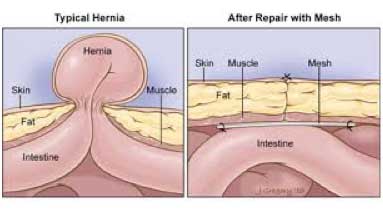Incisional Hernia
 An Incisional Hernia happens when a weakness in the muscle of the abdomen allows the tissues of the abdomen to protrude through the muscle. The weakness in the muscle is caused by the incision made in a prior abdominal surgery. The hernia appears as a bulge under the skin, and can be painful or tender to the touch. An Incisional Hernia is typically small enough that only the peritoneum, or the lining of the abdominal cavity, pushes through. If left untreated, Incisional Hernias can grow over time.
An Incisional Hernia happens when a weakness in the muscle of the abdomen allows the tissues of the abdomen to protrude through the muscle. The weakness in the muscle is caused by the incision made in a prior abdominal surgery. The hernia appears as a bulge under the skin, and can be painful or tender to the touch. An Incisional Hernia is typically small enough that only the peritoneum, or the lining of the abdominal cavity, pushes through. If left untreated, Incisional Hernias can grow over time.
Preparation for Incisional Hernia Surgery
There should be some preparation before the Incisional Hernia surgery. The major points are as follows.
- The patient may be asked to lose weight to improve the results after the surgery.
- Control diabetes is also necessary surgery.
- Routine blood and urine tests to be conducted before surgery.
- ECG and chest X-ray to be taken before the operation.
- Medications like aspirin should be discontinued.
- Patient should not drink or eat anything after midnight the night before surgery.
Procedure for Incisional Hernia Surgery
Depending on the location of the Incisional Hernia the patient will have to lie flat on the back or sidewise. A general anesthesia will be given after that. In some cases a local anesthesia will do. To decompress the urinary bladder, a catheter will be inserted into the bladder. If the hernia is near to the stomach, the stomach also will be decompressed using a gastric tube. An incision which is done to remove fat and scar tissue from the abdominal wall is the practice in an open procedure. The outside extra tissue from abdominal wall is usually removed. Mesh will be applied and is overlapped the weakened area in all directions. The suturing is done after that. They are tied down and knotted. In laparoscopic procedure, two to three small incisions will be done. One is used to insert laparoscope and other one to insert the surgical instruments. In this type of surgery, abdominal wall tissue removed is lesser.
Recovering from Incisional Hernia Surgery
Most hernia patients are able to return to their normal activity within two to four weeks. The belly will be tender, especially for the first week. During this time the incision should be protected during activity that increases abdominal pressure by applying firm but gentle pressure on the incision line. This is especially important for Incisional Hernia patients, as they are predisposed to an Incisional Hernia and can be at risk for another one at the new incision sites.
- Activities during which the incision should be protected include:
- Rising from a seated position.
- Sneezing, or coughing
- Bearing down during a bowel movement. Contact your surgeon if you are
- Constipated after surgery, a stool softener may be prescribed.
- Vomiting
- Lifting heavy object
Incisional Hernia Risk Factors
People who had abdominal surgery are at-risk for developing Incisional Hernias. They are especially susceptible three to six months following the procedure, when the tissues are still healing from the incision. Participating in strenuous activities, gaining a substantial amount of weight, or becoming pregnant can cause excessive stress on the healing abdominal tissue and should be avoided during this healing window in order to prevent Incisional Hernias and other post-surgical complications.
